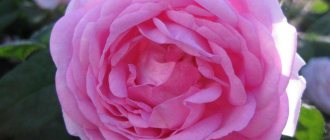2.Description
The genus "Oxalis" or oxalis includes about 500 species of very attractive herbaceous annual and perennial plants with small nodules . Most species do not form a stem and long, thin leaf petioles emerge directly from the tubers.
The leaves are complex, with reticulate veining, consist of 3 - 4 green, burgundy and even dark blue thin leaves of a heart-shaped or triangular shape, reminiscent of clover, folded at night or in cloudy weather. Leaf arrangement is opposite. There are varieties with leaves of two contrasting shades.
In spring, the plant produces tall erect or drooping flower stalks with pink, lilac, yellow, white or red flowers about 2 cm in diameter with a long flower tube. The flowers are solitary or collected in small umbels.
After flowering, if the flowers are pollinated, the plant forms round, greenish fruits with seeds. Ripe fruits open with force and can shoot seeds over a fairly long distance.
Oxalis flower - height . Most species do not exceed 30 cm in height. The final size of the plants will depend on the varietal characteristics and maintenance conditions.
Botanical description of wood sorrel
Oxalis is a genus of annual or perennial flowering herbs. They have a creeping superficial rhizome with tuberous or bulbous growths. The height of the plant is 15-30 cm. The leaves on petioles up to 20 cm long have a palmate or trifoliate structure. The length of the leaf is 5-15 cm. The leaf plate tends to fold and fall at night in cloudy weather or under physical stress. The color of the leaves can be green and burgundy, one-color or two-color.
Today, indoor oxalis is one of the most favorite plants among gardeners.
Flowering occurs in late spring or early summer and lasts about a month. A long peduncle grows from the axils of the leaves, which bears one or several buds. The corolla of regular shape consists of five petals fused into a short tube. They have a rounded, strongly bent outward edge. Similar to leaves, flowers close at night. The color of the petals is dominated by lilac, white, pink, and yellow shades. All flowers are bisexual, prone to self-pollination or pollination by insects. In the center of the flower there are 5-10 long thread-like stamens and a single ovary. Its column can be longer, shorter or even with the stamens.
The fruits are fleshy, oblong-shaped seed pods with green leaves. Behind them are small, drop-shaped seeds with thick skin. The top layer of the peel contains a large amount of sugars to attract ants. They are the ones who carry seeds over long distances. After the valve ripens, the oxalis berries open sharply, literally shooting out the contents over a long distance.
3.Planting and care in open ground
Varieties suitable for growing in the garden include ferruginous , nasturtium and carob, and the last 2 species can behave aggressively and quickly spread throughout the area, and therefore will need to be limited when planting. Plastic garden border tape or pieces of slate and iron can act as a limiter.
Planting seedlings in open ground is carried out in the second half of May - early June, when the threat of return frosts has passed.
The location is selected so that the bushes are shaded during the daytime and protected from strong winds.
To plant, the area is carefully dug up, weeds are removed and planting holes are prepared.
↑ Up,
The planting pattern—the distance between plants—will depend on the size of each variety.
At the bottom of the planting holes, you can lay out a nutrient layer of organic materials such as humus, well-rotted horse or cow manure.
Plants are placed in planting holes and buried in soil, compacting it when planting, and then watered abundantly .
Only transplanted bushes are watered abundantly and regularly, while plants that have already been kept outside for several months will endure short periods of drought .
Further care of the planted bushes will consist of timely watering, weeding and loosening of the soil, as well as periodic feeding.
3.1.Wintering
In the fall, before the onset of frost , the entire above-ground part can be cut off, and the root system remaining in the ground can be covered with spruce branches or fallen leaves for insulation.
↑ Up,
Garden sorrel: wintering features
Oxalis by their nature are perennial plants, but they are unlikely to survive our winters in the open ground. Although some species in the southern regions winter under the condition of shelter.
With the onset of autumn, the foliage of the bushes growing in the flowerbed begins to fade. From this point on, watering should be gradually reduced. Before frost, the sorrel must be dug up. The tubers are either dried or planted in a wide container with light soil and brought indoors. If the flower grows in pots, it is even easier to do this by simply moving the flower pots to the basement. Already in April, the nodules will begin to produce young leaves. Then the container can be exposed to light. With the arrival of warmer weather, you can transplant the sorrel into the flowerbed again.
During wintering in the basement, oxalis is not watered.
Some gardeners simply move the wood sorrel into the house, transforming it into a houseplant. This is quite possible, but it is better to give the flower time to rest between blooms.
Video about growing oxalis in the garden
4. Reproduction of wood sorrel
Most often, wood sorrel reproduces by dividing large specimens during transplantation.
If the sorrel has grown greatly and filled the entire volume of the pot, then the division of such bushes is carried out in the spring.
When dividing, make sure that the resulting flowers each have their own root system (several rhizomes) and a well-developed ground part. In each division it is worth leaving at least 10 nodules. If the bushes receive fewer rhizomes, recovery will take some time and there will be no flowering until the bush becomes a little crowded.
You can separate rhizomes from the main plant and plant them in separate containers as early as February.
- When planting, the nodules are buried in the soil to a depth of about 1 cm. From 5 to 10 plant nodules can be planted in each pot.
- Plants are watered with water at room temperature.
- Pots with flowers are left in partial shade, in cool conditions - at a temperature of 12 to 15⁰C.
- When the first leaves appear above the soil surface (about a month after planting), the young plants are taken to a place where there is good lighting without access to direct rays of the sun.
- The temperature during this period is increased to 22 - 25 ⁰C.
↑ Up,
Seeds that are sown in the spring in a loose and nutritious substrate consisting of a mixture of peat and coarse river sand. Unfortunately, germination often leaves much to be desired.
- Before sowing, the soil is thoroughly moistened using a fine spray bottle.
- The seeds are sown evenly on the surface of the ground and lightly pressed into it, without covering it with soil on top.
- The crops are covered with transparent plastic or glass on top to maintain a high level of humidity and shaded from direct sunlight.
- Seedlings are kept at a temperature of about 16 ° C.
- The first shoots may appear within 1 - 2 weeks, but the overall germination period is long and can take up to 18 months.
- With the appearance of the first shoots, the cover is removed, and diving into separate small cups is carried out when the bushes have several true leaves.
- After picking, 10 - 14 days later, you can carry out the first fertilizing with a highly diluted mineral fertilizer for ornamental foliage plants.
The first buds of sorrel obtained from seeds appear in the second year of life.
↑ Up,
Some species reproduce vegetatively - by cuttings .
- Stem cuttings 10 - 15 cm long are dusted with growth hormones at the base and rooted in a glass of water, to which you can add an activated carbon tablet.
- The water is changed every 5 - 7 days and after about 2 - 3 weeks the first roots appear on the plants.
- When the roots reach a length of 1 - 2 cm, the cuttings are planted in very loose and nutritious soil.
↑ Up,
For some time, such plants will not show any signs of growth - during this period their root system gets used to their new living conditions.
Rooting can be successfully carried out by immediately planting the cuttings in the substrate.
↑ Up,
Oxalis in the garden
Oxalis grows equally well in partial shade and on an open, sunny lawn. The soil should be nutritious, loose and breathable. Soil acidity is recommended to be neutral or slightly acidic. If necessary, before planting, dig up the soil with the addition of compost and peat. Young plants are planted at a distance of 10-12 cm to a depth of 3-4 cm. It is best to plant in the second half of spring in warm, cloudy weather.
Oxalis is a plant with positive energy.
Usually plants have enough natural precipitation. If the drought is prolonged, the bushes are watered in the morning or closer to sunset with a small amount of water.
Infrequently, every 1-2 months, sorrel is fed with a highly diluted mineral complex or “Mullein”.
In autumn, the heat-loving plant must be prepared for wintering. To do this, mulch the soil well at the roots. There is no need to worry about the condition of the above-ground part; it will dry out in any case, and a thick layer of mulch will help the tubers and roots survive until next spring.
5. Kislitsa - care at home
5.1.Soil
When grown at home, this ornamental plant prefers nutritious soil with a high organic .
The soil mixture can be made independently from components such as garden soil, peat, humus; turf or light leaf soil can be used as a loosening component.
A small amount of charcoal added to the mixture will improve the structure of the soil and add additional nutrients to it.
To improve drainage, add coarse river sand, perlite or vermiculite to the soil.
acidity should be between 5.5 and 6 .
↑ Up,
5.2. Oxalis transplantation
fills the pot very and needs to be replanted in the spring. Adult plants are transplanted every 3 - 4 years into a larger pot.
This flower tolerates transplantation easily .
- For planting, select a pot with large drainage holes and first of all, lay a drainage layer on its bottom in the form of river pebbles, broken bricks or expanded clay, which can be easily purchased at any flower shop.
- Preference should be given to shallow and wide pots - bowls.
- A small layer of fresh soil is poured onto the drainage layer and a bush is placed in the center of the pot.
- If there are no signs of disease or decay, then the plant can be moved along with the old clod of earth without destroying it. This method is called transshipment - it is less traumatic for the root system.
- After planting, the soil around the plant is thoroughly compacted to remove air pockets and the flower is watered.
- If after watering the soil has subsided significantly, add a little more fresh mixture.
Flowering or diseased plants should not be replanted - wait until flowering is over.
An exception to this rule may be flowers recently purchased in a store - they are often grown in a substrate poor in nutrients and after a week of acclimatization to new living conditions, such bushes are transplanted into new soil.
↑ Up,
When signs of rotting appear, the plants are replanted with a complete replacement of the soil - to do this, the bushes are removed and the roots are carefully shaken off from the remnants of the old mixture.
Rot-damaged areas of rhizomes are cut back to healthy tissue with sharp pruning shears and the wound surface is treated with crushed charcoal powder or ash.
Such specimens are planted only in a new substrate , since pathogens may remain in the old one.
Watering after transplantation is stopped for several days, giving the roots time to heal their wounds.
↑ Up,
5.3.Growing oxalis - watering
Keep the soil evenly moist . At this time, when the plant is actively growing green mass and forming buds, it needs good moisture - dry the soil between waterings to a depth of 1 - 1.5 cm .
In the fall, the frequency of watering will depend on whether the plant rests in a cool place. Some species retain leaves and need watering in winter.
If the plant goes into a dormant period, then in winter significantly reduce the frequency of watering and simply protect the earthen ball from drying out.
Adult bushes will withstand slight drying of the soil, since their root system contains small bulbs with a reserve of moisture.
Oxalis does not like either severe waterlogging or prolonged drought.
Excess moisture that appears in the pan after watering. drain after a few minutes.
For irrigation, use only well-settled water at room temperature . Also suitable for irrigation are bottled, filtered, melted, rain moisture collected away from city roofs.
↑ Up,
5.4.When oxalis blooms
May–July , flowers open during the day and close at night. Depending on the conditions of detention and varietal characteristics, flowering may occur at different times of the year .
With good care, some plants can bloom almost all year round.
Interestingly, many varieties open flowers in clear, sunny weather, but on cloudy days the buds may remain half-closed.
Each individual flower remains attractive for only a few days, but the buds constantly replace each other and the flowering period can last for several months .
Flowering will not occur in insufficient light.
↑ Up,
5.5.Feeding oxalis
In spring and summer, feed 2-3 times a month with mineral fertilizers for decorative foliage plants.
In autumn and winter, fertilizing is stopped until new growth begins in the spring.
The fertilizer is diluted to half the dose recommended on the package. Fertilizers with a high nitrogen will help plants form lush green mass, while fertilizers high in phosphorus and potassium will promote the formation of buds.
Apply the nutrient solution only to moist soil, after abundant watering, since contact with the roots of an overly concentrated solution in dry soil will lead to a burn.
Plants that are overweight or have just been transplanted should not be fed.
↑ Up,
5.6.Spraying
Tolerates dry air quite well , but it is worth spraying the leaves periodically to prevent pest invasion.
Spraying is carried out in the morning using soft water at room temperature. Droplets of moisture should have time to evaporate from the leaf plates before dusk. Remember that direct sunlight on wet leaf blades will cause burns - after all, water droplets act like a lens.
When spraying, moisture should also not get on the buds and flowers - they will sharply lose their attractiveness.
Also, to increase humidity, you can place a pot with a plant on a tray filled with wet pebbles . Make sure that the pot does not come into direct contact with water.
You can increase air humidity by grouping several plants in a small room or using a room humidifier.
Oxalis prefers to be in constantly ventilated areas with good air circulation, but does not like exposure to cold drafts.
↑ Up,
5.7.Oxalis content temperature
Oxalis prefers cool temperatures - about 18 ° C , but can grow quite successfully at normal living room temperatures.
In winter, the temperature is lowered to 6 - 12 ° C - such a cool winter allows the plant to rest. With the onset of cool weather, the bushes stop forming buds and slow down their development.
The flower welcomes changes in day and night temperatures.
Most plants do not have a clearly defined dormant period, and in the winter months, with good lighting, you can keep the flower at normal room temperature.
The dormant period is pronounced in varieties such as Depp's and Ortgis's - such plants finish forming buds in the fall and begin to shed their leaves before the onset of the winter months.
With the onset of summer heat, you should definitely increase the frequency of watering and air humidity. In general, it is undesirable for the air temperature to exceed 25 degrees Celsius.
↑ Up,
5.8.Lighting
The degree of illumination depends on the species. Many oxalis are shade-tolerant and grow and bloom well in partial shade; others require bright light to bloom abundantly.
The most suitable for growing are considered to be window sills facing east or west .
When growing in the north, it is worth organizing artificial lighting with fluorescent or phytolamps, and when keeping it on the south side, place a pot with the plant a little at the back of the room.
Prolonged exposure to direct sunlight on leaf blades during the daytime in spring or summer can lead to sunburn on the leaves.
Every week, the pot with the plant is turned a quarter turn around its own axis so that the flower is symmetrical and does not tilt towards the light source.
In autumn and winter, when the sun's activity is low and often remains behind the clouds, you can place the flower on the most illuminated windowsill.
↑ Up,
5.9.Home care, pruning
Quite easy to grow, undemanding plant.
Pick off fading flowers and leaves, which appear quite often and spoil the appearance of the plant. If necessary, trim only with a sharp, sterile instrument.
Many species periodically change leaves - old leaf blades die off and new ones appear. The foliage of such plants should be periodically combed - removing old, dried leaves with your hands to maintain an attractive and neat appearance.
Oxalis can go dormant in the fall - at this time the leaves become dry and die. In this case, cut off the entire above-ground part of the plant and place it in a cool place.
Place the plant outside in the warm season under cover from strong winds and rain, as well as shade from direct sunlight.
↑ Up,
Features of caring for oxalis: abundant watering and regular feeding
Caring for oxalis grown in captivity should include regular and abundant moisture and fertilizing in spring and summer.
How to water a flower
With the onset of warm days, oxalis needs frequent and abundant watering. You need to moisten the flower as needed. On hot summer days, the procedure can be performed daily in the morning and evening. During the same period, it is worth additionally spraying oxalis. During the day, experienced gardeners do not recommend doing this, since droplets of water falling on the delicate leaves can lead to burns.
In October, the flower begins a dormant period; at this time, watering should be reduced and spraying should be stopped altogether.
Does oxalis need feeding?
Fertilizers will help maintain the decorative appearance of the plant; thanks to a sufficient amount of nutrients, the foliage will have a juicy and bright color, and the petioles will not stretch, thereby preventing the bush from falling apart. It is recommended to fertilize twice a month from April to August.
To carry out the procedure, a complex preparation for decorative foliage indoor plants is suitable. You can use drugs in liquid form, for example, Kemira Lux or Fertika.
In order for the plant to grow abundantly foliage and bloom beautifully, regular feeding is necessary.
Flowering period
Under favorable conditions, oxalis usually begins to bloom in April and this process lasts until September. The buds replace each other and the impression of continuous flowering is created. Faded inflorescences do not need to be removed; they do not interfere with the development of oxalis. However, such plants do not look very neat, so the flower stalks can be cut off at the base.
Sometimes oxalis does not want to bloom. This happens especially often in very dark rooms. Solving the problem is very simple; to do this, just move the flower to a bright place, or even better, take the pot out onto the loggia or balcony. Outdoors, wood sorrel blooms profusely and for a long time.
Outdoors, oxalis blooms profusely and for a long time.
Formation of a bush
As they grow, the oxalis bushes begin to stretch out and fall apart. To prevent this from happening, the plant requires regular pruning. About once a month it is necessary to thin out the sorrel, cutting off excess leaves. This procedure will stimulate the appearance of new leaves and the bush will always be neat and fluffy.
Recent Entries
5 working ways to use tar in the garden 7 indoor plants that help you get married even in adulthood Indoor plants that can bloom in trouble
Rest period. Bulb storage
Oxalis requires a period of rest in winter. Some species (bulbous plants) themselves inform their owners about the need for rest; their aboveground part dies off in the fall. In October, the vegetative mass is cut off and watering of the flower is stopped. The bulbs are left in the ground and the pot is placed in a cool and dark room with a temperature of +12–14°C. The soil should not be too dry; if necessary, it should be slightly moistened. In the spring, as soon as the sprouts appear, the sorrel is placed in a sunny place and the substrate begins to be moistened abundantly. the flower very quickly increases its vegetative mass and begins to bloom within 1–1.5 months.
Species whose vegetative mass does not die off in the fall also require relative dormancy in winter. In December, they are transferred to a cool but bright room (or placed closer to the glass, separated from the warm room by a screen. The temperature for oxalis at this time should be +16–18 °C. Watering is reduced, the flower is watered after 2–3 days with cool water.
How care errors manifest themselves and how to correct the situation (table)
| Problem | Cause | Corrective measures |
| Leaves change color | Not enough sun rays | Move the plant pot to a sunnier location. |
| The leaves are withering | Overmoistening | When transplanting oxalis, ensure good drainage in the pot to remove excess moisture. Adjust the watering mode. Moisten generously, but after the soil in the container has dried. |
| Spots appeared on the leaves | Sunburn | Protect the plant from direct sunlight. |
| Tips of leaf blades dry out | Sunburn, high temperature and low humidity. | Periodically spray the plant with warm water in spring and summer. |
| Oxalis stretched out | Lack of sunlight | Trim the elongated leaves and place the flower in a sunny place on a windowsill facing east or west. |
| Leaves dry out and die | Natural process | Cut off the entire above-ground part and send the sorrel to a cool and dark room to rest. In spring the plant will begin to grow. |
Video: features of caring for oxalis (oxalis)
7.Purpose
Looks good when grown in a hanging basket as an hanging plant.
Oxalis is often used to cover the bases of large trees and in this case it is used as a ground cover flower.
A huge variety of varieties with different sizes and shades of leaves, with multi-colored buds has made wood sorrel a very popular plant in floriculture, and the compact size of the bushes allows you to collect fairly large collections in limited space.
When grown in open ground, sorrel bushes are used as a border plant for edging flower beds.
Many varieties have medicinal properties , in particular, leaves containing vitamin C are taken orally for colds, and a decoction of sorrel can have a diuretic and choleretic effect.
The plant is also credited with anti-inflammatory and wound-healing properties.
↑ Up,
Medicinal properties of sorrel
It has been known since ancient times that sorrel has medicinal properties. The aerial part of the bush was used for scurvy, as well as for the treatment of wounds and ulcers, and also as an antidote for mercury or arsenic poisoning. In alternative medicine, such properties of the flower as choleretic, wound healing, anthelmintic, anti-inflammatory and diuretic were widely used.
Since the foliage contains a lot of vitamin C, its use is recommended for colds, as well as to strengthen the body’s immune system. Oxalis is also widely used in cooking, for example, healthy and tasty tea is prepared from it, and it is also added to green borscht, cabbage soup or kvass.
Oxalis is an amazing plant that can delight you with its appearance all year round. Proper care will ensure regular flowering and an attractive appearance.
8.Note
The above-ground part of the sorrel contains toxins , but the plant can hardly be classified as poisonous - signs of poisoning appear only when a large amount of green mass is ingested.
At night, the leaves of some varieties are able to fold and droop; the flower will demonstrate the same behavior before the onset of rain.
If the bush has become too large and the pot is too small for it - the leaf blades become small and weakly colored, and flowering becomes scarce - it is necessary to rejuvenate the flower by dividing it into several parts when replanting.
↑ Up,
Hydroponics.
Crop varieties
There are several of them, and each requires special care:
- Indoor violet oxalis . The most popular variety. The plant is low-growing, with purple foliage and small white or soft pink flowers. Purple sorrel is kept in a warm and well-lit place. Propagated by leaf cuttings or by dividing the bush during transplantation.
- Quatrefoil or Depi . This variety can be grown both at home and in the garden. The four-lobed leaves are painted a soft olive color with a burgundy core. The shrub blooms with bright scarlet flowers. Europeans call this variety “lucky clover.”
- Common sorrel . Low-growing bush with single snow-white flowers.
- Oxalis multicolored . A very beautiful variety, which has gained great popularity due to the color of the flower - snow-white with deep red stripes.
9. Varieties of sorrel:
9.1.Oxalis or hare cabbage - Oxalis acetosella
A perennial herbaceous plant with green, complex, basal leaves 5 to 10 cm high. The leaves are collected in a leaf rosette and have long, thin, flexible petioles. The petioles are covered with slight pubescence. The leaves consist of three matte, heart-shaped segments. The surface of the leaf blades also has pubescence. The flowers are solitary, with oblong white petals with pink or lilac veins. The center of the flowers is yellow. Flowers are arranged singly on tall peduncles. In the evening hours and in cloudy weather, the leaves of the plant fold. The flowering period occurs in May - June. The leaves of this plant are considered edible, but contain large amounts of oxalic acid.
↑ Up,
9.2. Oxalis triangular, moth or Regnell - Oxalis regnellii
Tender perennial, evergreen, herbaceous plants up to 15 cm high. The leaves are basal, on long, thin petioles, complex - consist of three segments. The segments are triangular, green, or purple. The flowers are collected in small, few-flowered inflorescences on the tops of numerous erect, thin peduncles. The flowers are funnel-shaped, light lilac or white, consist of five oblong petals and reach a diameter of 1 cm.
Unlike most of its counterparts, this species does not tolerate direct sunlight during the daytime - the leaves will simply burn. Plants do well when kept in partial shade. The ideal location would be an east-facing window sill. It is better to tame the sun entering a window facing west with a light curtain. On a northern window, the flower will not have enough light, but in a southern location it is better to place the flower with a pot in the back of the room.
↑ Up,
9.3. Depp's sorrel or four-leaf - Oxalis deppei
Compact herbaceous, evergreen, perennial plants native to Mexico, do not exceed 15 - 40 cm in height. The leaves are compound, consisting of four heart-shaped segments located at the tops of thin, long basal petioles. There is slight pubescence on the surface of the leaf blades. The flowers are bright, attractive, pink, have rounded petals and a yellowish-green center, collected in small inflorescences on the tops of thin, erect peduncles. The flowering period is long - it begins in June and ends in October, but individual flowers can appear in any other months.
↑ Up,
9.4.Oxalis Deppei Iron Cross
Depp's oxalis, the main distinguishing feature of which is the presence of burgundy spots in the center of the leaf segments, which is why the plant received its name - iron cross.
↑ Up,
9.5.Oxalis corniculata
An attractive, perennial, herbaceous plant up to 40 cm high. The stems are creeping, thin, upon contact with the ground they produce roots at leaf nodes, and are covered with slight pubescence. The leaves are compound, consisting of three heart-shaped, pubescent segments. The petioles are relatively short - from 1 to 7 cm long, with slight pubescence. The peduncles are erect, short, thin, bearing at the top from 1 to 5 golden-yellow, cup-shaped flowers with five oblong petals. Leaf shades include all shades of green, burgundy, brownish and lilac.
↑ Up,
9.6. Red sorrel - Oxalis rubra
Evergreen herbaceous plants with compound, three-segmented, heart-shaped leaves in all shades of green. Sometimes there are plants with leaves colored brownish, burgundy or purple. The leaf petioles are long, slightly pubescent. The peduncles are erect, thin, flexible, bearing few-flowered inflorescences at the tops. The flowers are delicate - pink, white, lilac, yellow, with five petals.
↑ Up,
9.7.Oxalis tuberosa
A herbaceous plant, often not exceeding 50 cm in height, forming fairly thick, erect stems. The leaves are compound, consisting of three heart-shaped segments of bluish-green or green color. The stems often have a pink tint. The flowers are bright, funnel-shaped, collected in small inflorescences on vertical, tall, leafless peduncles. This sorrel has become widespread thanks to its edible tubers. The tubers are oblong and have a very varied color, including white, beige, red, burgundy, and brown shades. The tubers can reach 20 cm in length and up to 4 cm in diameter, have a slightly sour taste, reminiscent of sweet potatoes, and are eaten in South American countries.
↑ Up,
9.8. Variegated sorrel - Oxalis versicolor
Perennial evergreen herbaceous plants up to 30 cm high. The bushes form strong, erect, thick stems, abundantly branched at the base. The leaves are dark green, compound - consist of long segments slightly bent along the central vein. Thin, vertical peduncles bear on the tops the main decoration of this sorrel - funnel-shaped flowers with five rounded petals. The color of the petals is very unusual - the inside of them has a white tint, the outside of each petal has a bright red or burgundy edging. Even buds that are not fully opened look extremely impressive. Flowers open only in sunny weather; in cloudy weather they remain half-open. The flowering period is long, occurring in the summer months.
↑ Up,
9.9.Oxalis adenophylla
An evergreen herbaceous, dwarf perennial with creeping stems. With age, the plants form a dense herbaceous mat, which does not exceed 7–10 cm in height. The leaves are compound, round, and consist of four oblong, heart-shaped segments of a silvery-green hue. Leaf petioles are short. In the evening hours or in cloudy weather, the leaves have the ability to fold. The flowers are large, cup-shaped, pink, lilac or white, on short stalks. Flowering will be most abundant in the first half of summer, but individual buds may appear at any other time of the year.
↑ Up,
9.10.Straight sorrel - Oxalis stricta
A perennial herbaceous plant up to 25 cm high. The stems are erect, abundantly branched at the base, covered with small short pubescence. The leaves are compound, green, on small petioles, and consist of three heart-shaped segments that fold in cloudy weather and at night. The flowers are golden-yellow, funnel-shaped, axillary, with five oblong petals. The flowers can reach 2 cm in diameter.
↑ Up,
9.11.Oxalis ortgiesii
A herbaceous plant with erect, thick, burgundy stems from 15 to 30 cm in height. The leaves are compound, on long, thin petioles, and consist of three leaf segments, shaped like a fish tail. The leaf blades are glossy, bluish-green, green, with slight pubescence and branched veins, slightly recessed into the surface. The peduncles are thin, leafless, and bear at the top several yellowish, funnel-shaped flowers with five petals.
↑ Up,
9.12. Volcanic sour - Oxalis vulcanicola
A compact herbaceous plant up to 20 cm high. This species probably has the widest color palette in which the leaves are painted. These plants can be safely classified as decorative deciduous or flowering. The leaves are compound, on flexible, thin, long petioles, and consist of three heart-shaped segments. Leaf shades include green, burgundy, brown, orange, red, and yellow. There are variegated specimens, the leaf blades of which are painted with contrasting stripes. The flowers are funnel-shaped, with five oblong petals in golden, pink or yellow shades.
↑ Up,
9.13.Oxalis depressa
A perennial herbaceous plant up to 15 cm high, with age it forms an attractive, dense, herbaceous cover. The leaves are compound, light green, consist of 3 heart-shaped segments, on short petioles. The flowers are large, funnel-shaped, reaching a diameter of 3 - 4 cm. The petals are very delicate, in shades of pink, lilac, white, often with a greenish or yellow center. Flowering is very abundant and long lasting - starting in the summer months it often ends in November.
↑ Up,
How to grow Oxalis Depp?
Oxalis deppei (Oxalis deppei, O. Tetraphylla) is a highly ornamental plant. This is the most popular type of oxalis. Other names: Depp's Oxalis, False Shamrock, Flower of Happiness.
It is often grown as a potted plant. According to some flower growers, oxalis is a bearer of great luck. And all thanks to the unusual structure of the leaf. Its leaves are tetralobed (consisting of four simple leaflets, while other oxalis have three simple leaflets). And the leaf shape is similar to clover leaves. That's why so many people buy it as a houseplant.
[mwi_product sku=»207001,211011,207042,207076" img_width=»144" desc=»false» btn_link=»anchor» title_tag=»h3" cols=»4"]
But not everyone knows that oxalis can be used in the landscape. For example, Depp's oxalis is ideal for growing in open ground. Its green foliage with dark purple markings stands out from the crowd. It is suitable as a ground cover plant in carpet flower beds and rock gardens.
Depp's Oxalis comes from Mexico (Subtropical mountain climate). This is a charming perennial bulbous plant that grows up to 35 cm high and 10-30 cm wide. The leaves are divided into four sections, very delicate, bright green in color with dark purple markings closer to the center. They are very similar to butterflies that decided to rest a little on a stem. The leaf length is 3-4 cm. Its flowering begins in late spring - early summer and continues until November. The flowers are small, raspberry-red in color, collected in umbrella inflorescences of 5-10 pieces. Sometimes the flowers may have a yellow center. They are hermaphrodites (they have both male and female organs) and are pollinated by insects.
Oxalis is very easy to grow. It grows from a bulb, and like all bulbous plants, it requires a period of rest every year. Don't throw a plant in the trash when you think it's dying. Oxalis is preparing for a period of rest. With proper care, it will again delight you with its beauty. The first sign that the plant will soon rest is the death of the leaves.
Growing in open ground
:
Once you have received the bulbs, they should be planted immediately. If this is not possible, then keep them in the refrigerator on the bottom shelf (in a paper bag) before planting.
Read also: Hibiscus Syrian blue chiffon planting and care in open ground
Agricultural technology is the same as for gladioli. Depp's oxalis is suitable for growing in well-lit areas of the garden (requires more sunlight than other species). Cannot grow in the shade. Prefers soils that are sandy or medium loamy, acidic or neutral, moist, with good drainage. It does not like dry or heavy soils. Doesn't like lime. Prefers southern aspect. The bulbs are planted in groups at a distance of 7-10 cm from each other. Planting depth is about 5 cm (the closer to the soil surface, the better).
Frost resistance is low - oxalis can withstand -12.2 ° C (if the soil is well drained, otherwise - temperatures down to about -5 ° C). Therefore, the bulbs need to be dug up for the winter. They are collected in late autumn and stored in a cool place protected from frost. And in the spring they are planted in the ground again. In areas with warm winters, oxalis is left to overwinter in the soil (it is well mulched with a 5-centimeter layer of mulch).
Growing in pots
:
For planting oxalis, a mixture of compost and leaf soil with the addition of sand (2:1:1) is suitable. Depp's oxalis requires a lot of light (with no more than 25 percent shade). Therefore, place it in living rooms on a sunny window (but at the same time protect it from the hot rays of the sun at midday). The optimal temperature for growing indoors is 22-24 °C during the day and about 15 °C at night. Water the plant sparingly. The soil in the pot should be slightly moist. Allow the soil to dry out a little between each watering, and do not water the plant until it is dry to the touch. Feed oxalis monthly throughout the growing season using a balanced, water-soluble houseplant fertilizer (apply according to package directions). Fertilize every two to three weeks during active growth. Stop feeding the plant in autumn and winter (during the dormant period). During this period, stop watering. Move the pot with the plant to a dark, cool room and keep it for three months. The potted plant should be replanted every 2 years.
Attention
! All parts of wood sorrel (leaves, flowers and bulbs) are edible. Oxalis leaves contain oxalic acid, which gives them their pungent aroma. The leaves are edible, but should be consumed in small quantities as oxalic acid can interfere with the body's absorption of calcium (leading to nutrient deficiencies). Oxalis leaves and flowers can be consumed fresh or boiled. At the same time, both the leaves and flowers are very refreshing and thirst quenching when chewed fresh. They also make an excellent salad dressing.
[mwi_pro[mwi_product sku=»212026,212009,212013,212021,201001,201044,201046,201048" img_width=»144" desc=»false» btn_link=»anchor» title_tag=»h3" cols=»4"]Delivery bulbous plants in Ukraine (Kiev, Donetsk, Kharkov, Dnepropetrovsk, Zaporozhye, Ivano-Frankivsk, Kremenchug, Ternopil, Uzhgorod, Krivoy Rog, Lugansk, Odessa, Kherson, Sumy, Chernigov, Chernivtsi, Lviv, Poltava, Lutsk, Kirovograd, Cherkasy, Khmelnitsky, Simferopol, Sevastopol, Vinnitsa, Zhitomir, Nikolaev, Rivne, Yalta, Melitopol, Bila Tserkva).
Very simple plants include wood sorrel (Oxalis) from the sorrel family. Oxalis is also called sour or Depp's oxalis (from Latin oxys - sour). South America, Europe, Africa, Australia - this is its distribution area. The forests of central Russia are also suitable for this plant. Therefore, oxalis is a popular herbaceous plant in many countries. And the leaf of the plant - the shamrock - was so popular with the Irish that it adorns their coat of arms.
The plant is also called hare cabbage. And it got its book name because of the sour taste of the leaves, rich in vitamins. And therefore, the one who eats sorrel looks very fresh.
In total, there are approximately 800 different species of this flower in the world, which can look like grass, a bush, or a subshrub. Some varieties have rhizomes, bulbs or tubers. Oxalis may have three or more leaves. Flowers in the form of umbrella-shaped inflorescences can be white, pink, yellow, lavender and purple. The fruits are in the form of boxes that burst with a bang after ripening. In this case, the scattering of seeds occurs within a radius of about 2 m. Among the entire variety of these plants, the largest number are ornamental species, although there are also weeds. These Oxalis really look like weeds.
Among all types of oxalis, there are several dozen that are most suitable for growing at home. These include:
- Oxalis Dippey Iron Cross (also called Oxalis Iron Cross or Depp's oxalis). A small pink flower that blooms only in the summer months.
- Oxalis four-leaf. The plant is quite shade-tolerant, so in winter the four-leaf sorrel is kept in the shade.
- Oxalis Versicolor. It has another name - variegated sorrel.
- Regnell's sorrel. Interestingly, Regnell's wood sorrel prefers a cold room.
- Oxalis Ortgis, which came to us from Peru. Oxalis Ortgis has brown-red stems and is an evergreen species of Oxalis Oxalis, just like Carob Oxalis.
- Oxalis ferruginosa, with white flowers. Ferruginous oxalis comes from Chile and Argentina.
- Purple oxalis, which is characterized by obverse-heart-shaped leaves and pink flowers. Purple oxalis is very pretty.
- Rose sorrel or, as it is also popularly called, clover of happiness. There are various signs on this score, from which we know that great family happiness and a lot of love await the person who has such a flower growing in his house. Although this is a superstition, many people believe in it.
- Oxalis volcanica, with yellow flowers. Volcanic acid is used mainly to decorate alpine slides.
- Red sorrel, which has fairly large shoots - more than 40 cm. In addition, red sorrel has leaves that are fleecy at the base.
Read also: Why the curtains must be open during takeoff and landing
Oxalis is recognized by many peoples of the world as a flower of happiness. The flowerpot is quite often given to family, friends, and relatives before the New Year as a gift.
Golden Cape can be considered a real beauty. All types of this plant are beautiful, but Iron Cross oxalis (Iron) is incredibly beautiful. The martian sorrel is also very pretty. But tuber sorrel and fleshy sorrel are grown for the purpose of using their tubers for food.
A rather rare species is wood sorrel. An interesting post appeared on the flower forum from one of the visitors, who wrote that she really wanted to buy this tree-like plant. And I even bought two. Their structure is exactly the same as that of a tree. She placed the flowers in one wide pot. “But the plants,” she says, “don’t grow, and the foliage turns yellow, withers and dries.” A friend advised me to plant both “trees” and distribute them so that they “lived” separately. But that didn't help either. What to do? Why do the leaves wither? How to care? As it turned out, this happens if the soil is very acidic (pH less than 5.5).
There is also street sorrel with green leaves and burgundy spots on the tubers.
It happens that large sedum is mistaken for hare cabbage: their external features are very similar. But these are two completely different plants, and among the sedums of various types there are many toxic ones. By the way, most toxic plants are used for medicinal purposes, including such popular ones as wood sorrel, sedum, and lily of the valley. But duckweed is non-toxic, but it removes various toxic substances from the intestines.
Diseases and pests
Oxalis gets all the diseases due to improper care. Excessive watering at low temperatures and underwatering in a hot room, untimely application of fertilizers are all the main reasons for the development of diseases and death of the flower. If favorable conditions are created for the shrub, insect pests will not appear on it.
- At low humidity, spider mites can settle on the plant. You can get rid of it with the help of insecticides.
- Mealyworms like to settle in the axils of leaves. It is removed with a cotton swab soaked in alcohol.
- With excessive watering, the flower develops gray rot or fusarium. Treatment for diseases consists of treatment with foundationazole. And also when there is an excess of moisture, the foliage wilts. There is one caveat: if the plant dries out and sheds its leaves in winter, then this is a harbinger of the beginning of the dormant period, and not a disease.
- If the room temperature is high and the air humidity is low, the leaves of the sorrel wither. This can also happen if the plant is grown in full sun.











